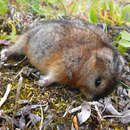en
names in breadcrumbs


Predators of the Varying Lemming include Norwegian snowy owls, Norwegian short-eared owls, ermines, foxes, wolves, pomarine jaegars, least weasels, falcons, gulls, hawks, wolverines and the polar bear (HInton, 191926; Wooding, 1982)
It is uncommon for this species to live longer than one year in the wild (Marsden, 1964).
Perception Channels: tactile ; chemical
US Federal List: no special status
CITES: no special status
IUCN Red List of Threatened Species: least concern
Eskimos use the soft white winter coats of the collared lemming for clothing decoration and toys for the children (Nowak, 1999).
The diet of D. groenlandicus consists of willow buds, fruits, flowers, grasses and twigs (Wooding, 1982). They will eat mushrooms and mosses in captivity. The morphology of the teeth suggests that they prey on insects, but this behavior has not been observed by individuals in the wild (Marsden, 1964; Nowak, 1999).
Tundra biomes of Alaska; arctic islands of Canada, Northwest Territories; Greenland; St. Lawrence Island and Wrangel Island(Siberia) (Nowak, 1999; Wooding, 1982).
Biogeographic Regions: nearctic (Native ); palearctic (Native )
D. groenlandicus is mainly terrestrial and fossorial, however, this lemming can also be found swimming in the arctic waters.
Terrestrial Biomes: tundra
Average lifespan
Status: captivity: 3.3 years.
The collared lemming is short and stocky with a very heavy coat year round. Pelage varies with the seasons: in summer the coat is light to dark grey with a buffy to reddish brown tone. Dark lines down the back and on the sides of the head are characteristic, however, the length of the stripe varies from ending just before the withers, to continuing down the length of the back (Hinton, 1926). The winter coat color is uninterrupted white. Dicrostonyx is the only genus in Rodentia in which the individuals have completely white coats in the winter season.
The head and body length equal approximately 100-157 mm with a tail of between 10 and 20 mm. This species is fossorial, developing a unique double digging claw in the winter to break through the ice and snow of the tundra (Marsden, 1964; Nowak, 1999). D. groenlandicus can easily be distinguished from other species of the genus by its narrow rostrum, smaller, straighter incisors and the unusually short hind foot (Hinton, 1926).
Range mass: 30 to 112 g.
Other Physical Features: endothermic ; bilateral symmetry
Average basal metabolic rate: 0.459 W.
The female estrus cycle lasts for 9.6 days, occuring several times in the breeding season, which runs from January to September (it may begin early depending on the severity of the weather). After a 19-21 day gestation, a litter of between 1 and 11 is born. A female typically has two to three litters per year in the wild; however, in captivity they can have up to five. The young weigh 3.8 g (average) at partruition and are weaned at 15-20 days (Marsden, 1964; Nowak, 1999).
Key Reproductive Features: gonochoric/gonochoristic/dioecious (sexes separate); sexual
Average birth mass: 4.35 g.
Average gestation period: 20 days.
Average number of offspring: 3.4.
Average age at sexual or reproductive maturity (male)
Sex: male: 85 days.
Average age at sexual or reproductive maturity (female)
Sex: female: 40 days.
The northern collared lemming or Nearctic collared lemming (Dicrostonyx groenlandicus), sometimes called the Peary Land collared lemming in Canada, is a small lemming found in Arctic North America and Wrangel Island. At one time, it was considered to be a subspecies of the Arctic lemming (Dicrostonyx torquatus). Some sources believe several other species of collared lemmings found in North America are actually subspecies of D. groenlandicus.[2]
It has a short chunky body covered with thick grey fur with a thin black stripe along its back and light grey underparts. It has small ears, short legs and a very short tail. It has a pale brown collar across its chest. In winter, its fur turns white, and it has large digging claws on its front feet. It is 14 cm long with a 1.5 cm tail and weighs about 40 g.
It is found in the tundra of northern Canada, Alaska and Greenland. A disjunct population is also present on Wrangel Island in Siberia; this population was formerly considered its own species, the Wrangel lemming (D. vinogradovi).[3][4][5]
It feeds on grasses, sedges and other green vegetation in summer, and twigs of willow, aspen and birches in winter.
Predators include snowy owls, gulls, wolverines, the Arctic fox and the polar bear.
Female lemmings have two or three litters of four to eight young in a year. The young are born in a nest in a burrow or concealed in vegetation.
It is active year-round, day and night. It makes runways through the surface vegetation and also digs burrows above the permafrost. It burrows under the snow in winter. Lemming populations go through a three- or four-year cycle of boom and bust. When their population peaks, lemmings disperse from overcrowded areas.
The northern collared lemming or Nearctic collared lemming (Dicrostonyx groenlandicus), sometimes called the Peary Land collared lemming in Canada, is a small lemming found in Arctic North America and Wrangel Island. At one time, it was considered to be a subspecies of the Arctic lemming (Dicrostonyx torquatus). Some sources believe several other species of collared lemmings found in North America are actually subspecies of D. groenlandicus.